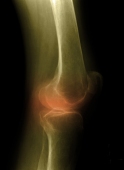
FRIDAY, Aug. 5 (HealthDay News) — In a decade or so, people now clamoring for metal and ceramic replacement joints may instead be able to have a fully functional biological replacement — a joint grown within their own bodies to their specific physiology.
To date, researchers have successfully grown replacement shoulder joints in rabbits, using an implanted biological “scaffold” upon which new cartilage developed, according to a study reported in The Lancet.
“It’s definitely a major step forward,” said Dr. Thomas A. Einhorn, chairman of orthopaedic surgery and a professor of orthopaedics, biochemistry and biomedical engineering at Boston University and a spokesman for the American Academy of Orthopaedic Surgeons. “It’s excellent work.”
However, people with arthritis or degenerative joint conditions should not expect to take advantage of this medical advance any time in the immediate future. Clinical use of the new technology is still a decade or more away, said Einhorn and Dr. James L. Cook, a veterinarian and director of the Comparative Orthopaedic Laboratory at the University of Missouri, and a member of the research team.
“You’re probably looking at the eight- to 10-year mark before it becomes widely available,” Cook said. “I tell everyone we’re working as hard as we can. I get a ton of calls from patients who say, ‘I’ll fly wherever I can, I’ll pay whatever I have to, I’ll sign whatever you want me to. I don’t want metal or plastic. I don’t want an artificial joint.'”
The new process works by implanting in the damaged joint what’s called a bioscaffold, which has been infused with a medication known as transforming growth factor beta-3. The drug encourages the body’s own cells — stem cells included — to become cartilage and bone cells.
The scaffold is made from polycaprolactone, a biodegradable plastic, and hydroxyapatite, a naturally occurring mineral found in bone and teeth.
Researchers removed the entire humeral head — the ball part of ball-and-socket shoulder joints — from rabbits used as test subjects and then implanted the scaffolds to grow a biological replacement for the missing piece.
The study reported that the rabbits implanted with the drug-infused scaffolds were able to use the joints and support themselves with them faster and more consistently than rabbits not given the scaffolds. After four months, a new cartilage surface for the humeral head had grown in place, with no complications or adverse effects, the researchers reported.
“They’ve been able to demonstrate that using a specific type of scaffold that’s been doped with a specific type of growth factor, cells will basically populate the scaffold and create cartilage,” Einhorn said.
Though apparently sound, the process still faces years of testing, mainly because it involves the use of an experimental cell growth factor, Einhorn and Cook said.
“We feel that clinically it works, but there’s still a lot of safety testing on the human side to get [U.S. Food and Drug Administration] approval,” Cook said. “The FDA wants to see it’s safe, it’s the same product every time, and there are no problems with disease transmission or infection.”
Einhorn said the durability of the biological joints also must be considered.
“The stability needs to be tested,” he said. “Is it going to be able to withstand the wear and tear that occurs through use on a daily basis, or is it something that just looks good now but will break down quickly?”
Cook has high hopes that the biological replacement joints will prove superior to the artificial joints now used, providing recipients with a higher degree of function.
“A metal and plastic joint is at its best condition the day you put it in,” he said. “The plastic wears out. Even the metal can wear out. A biological joint can actually improve over time as it adapts to your body.”
And though excited and intrigued by the research, Einhorn warned that people should not get their hopes up too soon.
“It’s not an answer for the middle-aged patient who has arthritis now, but it may be an answer for the middle-aged patient who has arthritis in the next 10 to 20 years,” he said.
More information
The American Academy of Orthopaedic Surgeons has more on joint replacement.

